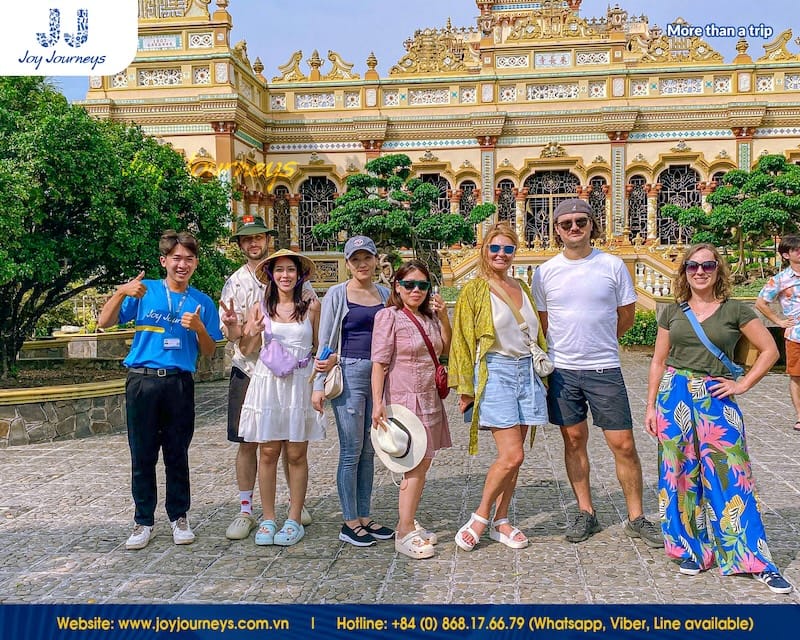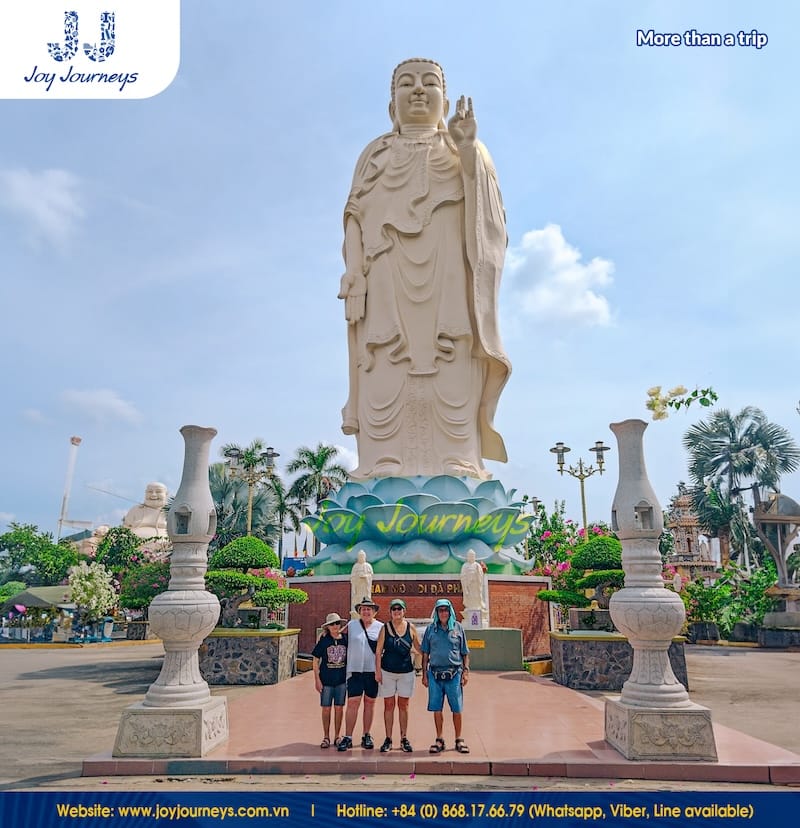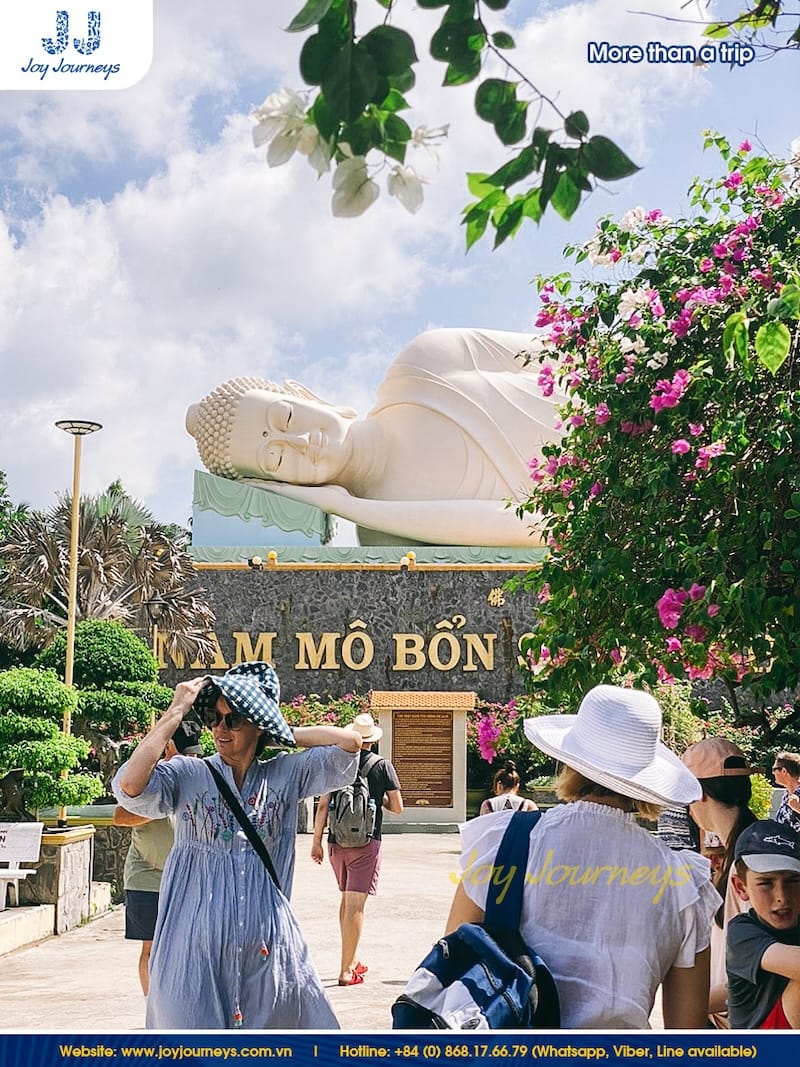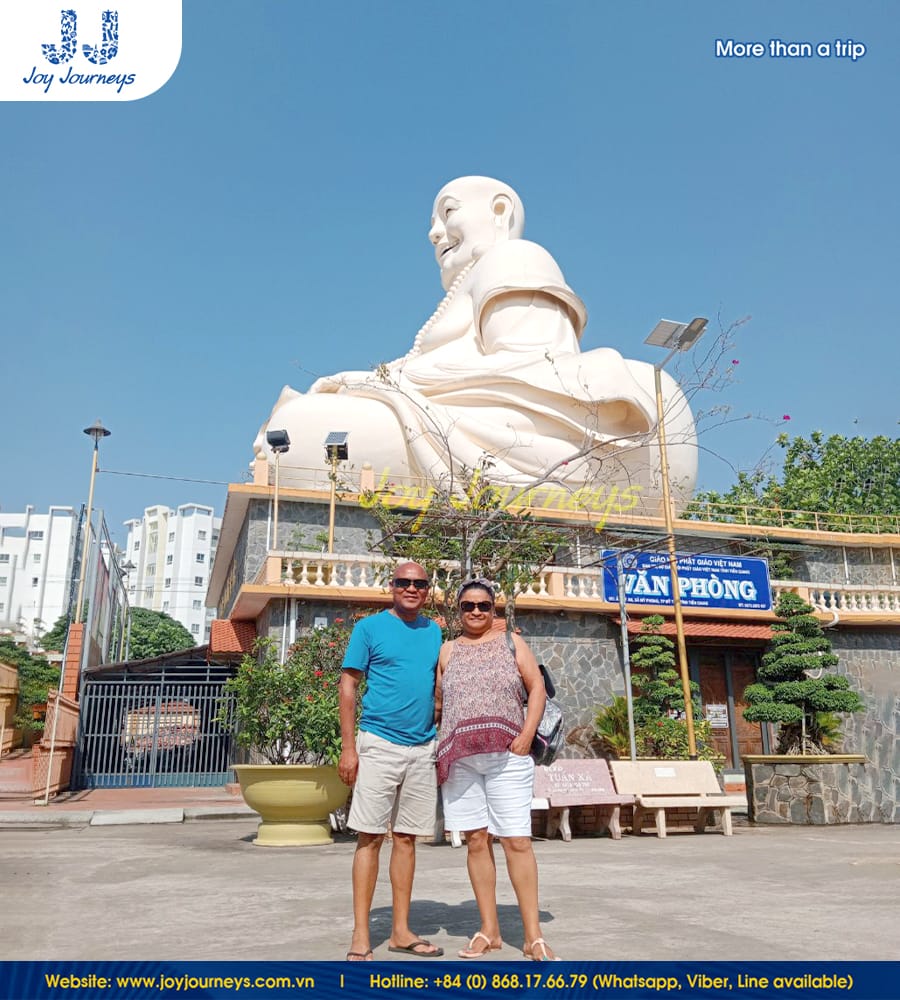Nestled in the heart of My Tho City, Vinh Trang Pagoda stands as one of the most magnificent and historically significant religious sites in the Mekong Delta region. This architectural masterpiece, with its unique fusion of Eastern and Western design elements, has captivated visitors for years. As one of the premier My Tho attractions, the pagoda offers travelers an extraordinary glimpse into Vietnam’s rich cultural heritage and spiritual traditions.
Contents
Vinh Trang Pagoda: An Overview

Vinh Trang Pagoda represents far more than just a religious site – it’s a testament to Vietnam’s cultural diversity and architectural innovation. Located on Nguyen Trung Truc Street in My Tho City, Tien Giang Province, this sprawling complex covers an impressive 20,000 square meters and serves as the largest pagoda in the province.
Vinh Trang temple, recognized as a National Historical and Cultural Relic since 1984, is noted in the Vietnam Book of Records for being the first pagoda in the country to feature a unique architectural style blending Eastern and Western elements.
What makes Vinh Trang Pagoda My Tho truly exceptional is its harmonious blend of Vietnamese, Chinese, Khmer, French, and Roman architectural influences. This unique fusion creates an atmosphere that is both spiritually profound and visually stunning, making it an essential stop for anyone exploring things to do in My Tho.
The pagoda’s significance extends beyond its architectural beauty. As one of the most important buddhist temples in vietnam, it serves as a spiritual center for the local community while welcoming thousands of international visitors who come to experience its peaceful atmosphere and cultural richness.
A Journey Through Vinh Trang Pagoda History
The Vinh Trang Pagoda history begins in the early 19th century when it was originally constructed by district chief Bui Cong Dat during the reign of Emperor Minh Mang (1820-1840). Initially built as a modest thatched hut known locally as Ong Huyen Pagoda, it was later renamed Vinh Trang in 1849.
The pagoda’s transformation into the magnificent complex we see today occurred under the guidance of Venerable Thich Hue Dang, who became the abbot in 1894. He organized the construction of a large temple and named it “Vinh Truong,” meaning “Eternal for mountains and rivers, eternal for heaven and earth”. This name reflects the spiritual aspirations and enduring nature of the sacred site.
Throughout its history, the pagoda has undergone several significant renovations that have shaped its current appearance. In 1907, Venerable Tra Chanh Hau repaired the main hall, introducing the distinctive mix of Asian and European architectural features that define the pagoda today. The most comprehensive restoration took place in 1930 under Venerable Minh Dang, who completely renovated the complex to achieve its impressive current form.
The pagoda faced challenges during the French colonial period between 1859 and 1862, when it was seriously damaged during battles between French forces and the Nguyen dynasty. However, the resilient community rebuilt and restored the temple, demonstrating the deep spiritual connection locals have with this sacred site.

Exploring the Pagoda Complex
What to see at Vinh Trang Pagoda encompasses a remarkable collection of architectural elements, religious artifacts, and artistic treasures that reflect centuries of cultural exchange and spiritual devotion.
The Main Hall
The main hall represents the heart of the Vinh Trang Pagoda complex, showcasing the most impressive examples of the pagoda’s unique architectural fusion. Built in the form of the Chinese character “Quốc” and roofed with distinctive red tiles, the structure covers 1,400 square meters and includes four consecutive spaces: the front hall, main hall, ancestral house, and back house.
The exterior resembles a French-style house with concrete construction, while the interior maintains traditional Chinese and Vietnamese architectural features. Slender columns line the facade and corridors, combined with arched windows decorated with Roman architectural patterns mixed with Western Renaissance style elements. The iron gates and windows further enhance the French villa aesthetic.
Inside the main hall, visitors can admire over 60 Buddha statues crafted from wood, bronze, terracotta, and cement. Many of these statues are gilded with shining gold and were carved in the late 19th century, representing exceptional examples of Vietnamese religious artistry. The rows of pillars inside are made from precious wood, and visitors can observe panels on the roof and pillars adorned with Chinese couplets.
The Courtyard and Gardens
The pagoda’s courtyard and gardens create a serene environment that enhances the spiritual atmosphere of the complex. The beautifully maintained grounds feature colorful flowers, carefully tended bonsai trees, and tranquil lotus ponds that provide perfect settings for meditation and reflection.
A particularly striking feature is the miniature rockery that depicts mountains, pagodas, and towers rich in Vietnamese identity. This artistic landscape connects the various areas of the complex while creating a square open space featuring lush greenery that serves as a peaceful retreat from the outside world.
The gardens also contain fruit trees that add to the natural beauty of the complex while providing practical benefits to the temple community. These green spaces demonstrate the pagoda’s integration with nature and its role as a sanctuary for both spiritual practice and environmental harmony.
Statues and Artwork
The pagoda complex houses an impressive collection of Buddha statues that serve as focal points for worship and artistic appreciation. Three main Buddha statues create particularly memorable impressions on visitors: a standing praying Buddha at the entrance gate, a smiling sitting Buddha, and a reclining Buddha in the main courtyard.
The entrance gate itself represents a masterpiece of artistic craftsmanship, built by an artisan from the imperial city of Hue in 1933. The gate includes three parts: the entry, a small story housing a Buddha statue, and an exquisitely decorated roof featuring joining porcelain pieces that create dragons, unicorns, tortoises, phoenixes, and fish. These decorative elements use Vietnamese and Chinese porcelain with green glaze, creating iridescent colors that captivate visitors.
The complex also features 178 intricately carved pillars adorned with impressive woodworks and sculptures, including the famous set of eighteen Arhant created by several renowned artists. These artistic elements demonstrate the exceptional skill of Vietnamese craftsmen and the pagoda’s role as a center for religious art.

Practical Information for Visiting Vinh Trang Pagoda
Getting There: How to Get to Vinh Trang Pagoda
Getting to Vinh Trang Pagoda My Tho from Ho Chi Minh City involves several convenient transportation options. The pagoda is located approximately 90 kilometers from Ho Chi Minh City and 4 kilometers from My Tho city center.
For independent travelers, take a bus from Ho Chi Minh City’s Mien Tay Bus Station to My Tho City, then use a taxi or motorbike taxi (xe om) to reach the pagoda. If traveling by motorbike from Ho Chi Minh City, follow National Road 1A towards My Tho City, then continue on Provincial Road 819 for about 3 kilometers until reaching Vinh Trang Park, make a left turn and proceed for another 300 meters to arrive at the pagoda.
The most convenient option for many visitors is joining a Mekong Delta attractions tour that includes transportation and expert guidance, eliminating navigation concerns while providing cultural context.
Vinh Trang Pagoda Opening Hours and Entrance Fees
Vinh Trang Pagoda opening hours are generous, welcoming visitors from 6:30 AM to 7:00 PM daily. The pagoda operates seven days a week, making it accessible for visitors regardless of their travel schedule.
Visiting Vinh Trang Pagoda is free of charge. However, donations are welcomed and contribute to the ongoing care of this historic site.
Dress Code and Etiquette
When visiting Vinh Trang Pagoda, appropriate attire and respectful behavior are essential. Visitors should dress modestly, covering shoulders and knees as a sign of respect for the religious significance of the site. Remove shoes before entering the main hall and other sacred spaces within the complex.
Maintain quiet, respectful behavior throughout your visit, as the pagoda remains an active place of worship where monks conduct daily prayers and ceremonies. Photography is generally permitted, but be respectful when taking pictures, especially during religious activities or when monks are present.
Tips for Your Visit Vinh Trang Pagoda My Tho
The best time to visit Vinh Trang Pagoda is early morning or late afternoon when temperatures are cooler and lighting conditions are optimal for photography. Arriving early also helps avoid larger tour groups that typically visit during mid-morning hours.
Allow at least 30-45 minutes to explore the complex thoroughly, though photography enthusiasts and those interested in architectural details may want to spend longer. The pagoda’s beautiful architecture and peaceful gardens provide numerous opportunities for memorable photographs.
Consider combining your visit with other My Tho attractions such as the floating markets, fruit orchards, or boat trips through the Mekong Delta waterways. This creates a comprehensive cultural experience that showcases different aspects of the region’s heritage and natural beauty.

Travel to Vinh Trang Pagoda With Joy Journeys
Joy Journeys offers exceptional Mekong Delta attractions tours that include Vinh Trang Pagoda as a key highlight. Their “Local ‘Lesser-Known’ Mekong Delta My Tho 1-Day Tour” provides an authentic experience that combines the pagoda visit with other cultural attractions in the region.
The tour includes a visit to the 100-year-old Vinh Trang Pagoda, showcasing the unique blend of Roman, Cambodian, and Vietnamese architecture. Joy Journeys’ expert guides provide detailed historical context and cultural insights that enhance your understanding of this remarkable site.
Our small group approach (maximum 10 travelers) ensures personalized attention and meaningful cultural exchanges throughout your visit. The tour also includes boat journeys through four beautiful islands, traditional folk music performances, and authentic local dining experiences that complement the pagoda visit.
FAQs
How long does it take to visit Vinh Trang Pagoda?
A typical visit to Vinh Trang Pagoda takes 30-45 minutes, allowing time to explore the main hall, courtyard, gardens, and admire the various Buddha statues and architectural details. Photography enthusiasts or those particularly interested in architecture and religious art may want to spend up to an hour exploring the complex thoroughly.
Are there guided tours available?
Guided tours are available through various operators, including Joy Journeys, which offers comprehensive Mekong Delta attractions tours that include Vinh Trang Pagoda with expert English-speaking guides. These tours provide valuable historical context and cultural insights that enhance the visit experience.
Is there a dress code for visiting the pagoda?
Yes, visitors should dress modestly with covered shoulders and knees as a sign of respect for this active religious site. Remove shoes before entering the main hall and other sacred spaces, and maintain quiet, respectful behavior throughout your visit.
Experience the tranquility and architectural beauty of Vinh Trang Pagoda on your next visit to My Tho. This remarkable site offers a unique window into Vietnam’s cultural heritage and spiritual traditions. Plan your trip with Joy Journeys to discover this architectural masterpiece along with other fascinating Mekong Delta attractions that showcase the region’s rich history and natural beauty.



Related Posts
Saigon’s “Flower Market Replica”: Where To Find Them
Ho Chi Minh City’s floral charm is not limited to its bustling wholesale markets. Imagine wandering through a place where vibrant petals, fragrant blooms, and the spirit of traditional Vietnamese markets come alive—without the overwhelming crowds. A flower market replica captures that magic, blending the beauty of fresh flowers with the charm of a curated, […]
Is it Safe to Travel to Vietnam Right Now? A Complete 2025 Guide
Vietnam has emerged as one of Southeast Asia’s most captivating destinations, drawing millions of visitors annually with its rich culture, stunning landscapes, and incredible cuisine. However, many travelers still ask: Is it safe to travel to Vietnam right now? This comprehensive guide provides you with everything you need to know about Vietnam travel safety in […]
Ho Chi Minh Cu Chi Tunnels Tour: The Ultimate Guide
The Cu Chi Tunnels stand as one of Vietnam’s most remarkable historical sites, offering visitors a profound glimpse into the ingenuity and resilience displayed during the Vietnam War. For travelers, a Ho Chi Minh Cu Chi tunnels tour represents an essential experience that combines education, adventure, and deep cultural understanding. This comprehensive guide will help […]